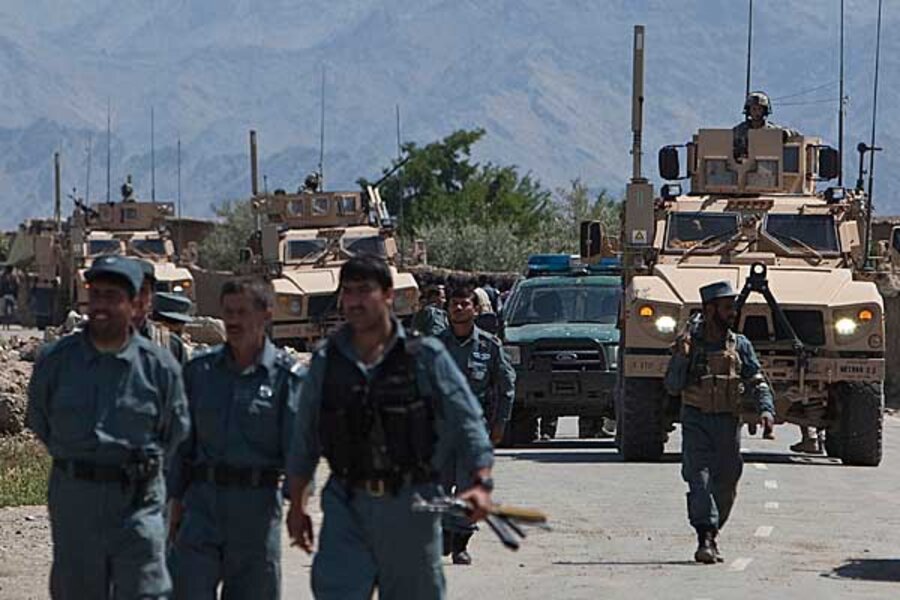Bagram attack kills US contractor, wounds nine NATO soldiers
Loading...
• A daily summary of global reports on security issues.
UPDATED AT 1:30 EST: An American contractor died in this morning's attack on Bagram Air Base.
"One US contractor was killed, nine service members were wounded, and a building received minor damages during the attack," Bagram Media Center said on its web site, which was being updated throughout the day. "Two of the nine wounded were returned to duty, all others are currently in stable condition. The name of the deceased is being withheld pending next of kin notification."
--
Afghanistan Taliban militants attacked the heavily fortified American military base at Bagram early Wednesday in a clash that left at least nine NATO soldiers wounded and 11 attackers dead. It followed a separate Taliban suicide bomb attack Tuesday that killed six foreign troops in Kabul, pointing to the resiliency of the insurgency and the continued vulnerability of the capital region.
The Taliban claimed that seven suicide bombers detonated themselves at one of the entrances to the base, clearing the way for 20 Taliban fighters to enter the complex, reports The New York Times, which notes that the militia’s claims are often exaggerated. Citing an unnamed US official, the Times reports that at least 30 insurgents were involved in the attack.
The US-led International Security Assistance Force (ISAF) has been quick to deny the Taliban’s claims to have breached the base, which is a major hub of NATO operations located just 50 miles north of the capital, Kabul.
“Though it is clear the enemy intended a spectacular event here at BAF, they were unable to breach the perimeter and unable to detonate their suicide vests,” military spokesman Lt. Col. Clarence Counts Jr. noted in a prepared statement on the ISAF website. “The quick defensive reaction by the Bagram security forces likely saved a lot of lives.”
Bagram press officer Maj. Virginia McCabe also cast doubt on claims that suicide bombers had been involved. "We know there are claims of suicide bombers but we are not aware of it at this time," McCabe told Al Jazeera.
McCabe later told Agence France-Presse (AFP) that nine NATO troops had been wounded in the assault, although it is possible that figure will continue to rise.
AFP interviewed eyewitnesses to the attack from a neighboring village who described a confusing early morning battle involving suicide bombers and US helicopter gunships:
The group of insurgents launched their attack at dawn, according to witnesses in Nawdeh village next to Bagram airfield who said they were forced awake by US military helicopters and the sounds of gunfire.
"It was around 4:00 or 4:30 am," said Zemarai Malikzada, in his 30s. "I saw American helicopters flying overhead, they were firing down and the terrorists were firing at them from there," he said pointing to vineyards.
Ahmad Jawad, a farmer who sets out for work before the sun rises and the temperatures climb, said he saw a man wearing a suicide vest. "I saw one of them. I went towards him. He showed me his bombs on his chest. I ran away. He ran towards those vineyards. Police and the Americans followed him then he exploded, right in there," he said, pointing to a vine about 80 yards from the paved road.
The Bagram attack comes just one day after a suicide car bomber hit a NATO convoy in Kabul’s rush hour traffic, killing six foreign troops – five Americans and one Canadian – as well as 12 Afghan civilians. It was the deadliest attack on NATO forces inside the capital since September and may be the start of a new Taliban spring offensive against the government, foreign forces, and diplomats in Afghanistan in response to NATO plans for an operation against the group's southern stronghold of Kandahar, according to Reuters.
"The Taliban are trying to show their reaction to the expected plan of NATO's operation in Kandahar in coming weeks," Noor Ul-Haq Ulomi, a former general during the communist regime of the 1980s, told Reuters. "[They] want to show ahead of it that they are strong as before and even getting stronger ... They want to show that with their small groups they are able to conduct organised attacks on NATO forces in Kabul and on their base in Bagram."
Kabul is in many ways the least friendly environment for the Taliban: it's the seat of the Afghan national government, home to scores of foreign military and development officials, and predominantly ethnic Tajik while the country as a whole – and the Taliban movement – are mainly Pashtun.
The Atlantic's Max Fisher writes that Tuesday’s assault demonstrates the Taliban’s resilience nine years after the US-led invasion. “That the Taliban were able to recruit within Kabul and to prepare, plan, and execute such a major attack in the city demonstrates that the group maintains access to even the least Taliban-friendly corners of Afghanistan,” Mr. Fisher says.
Related:





